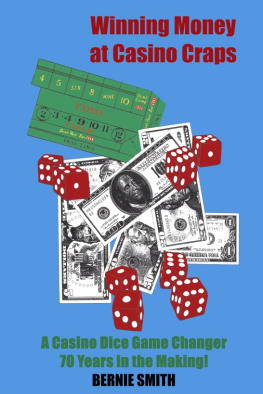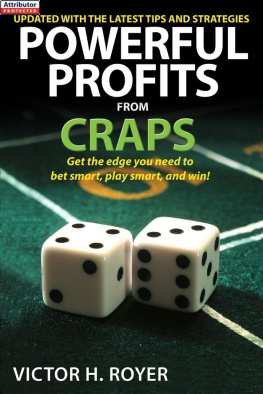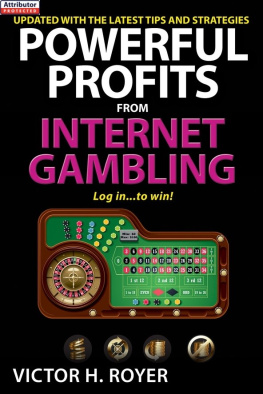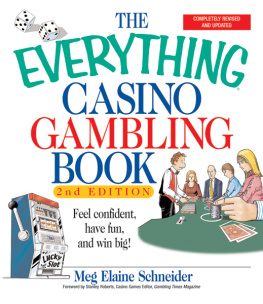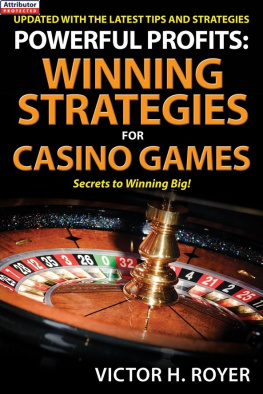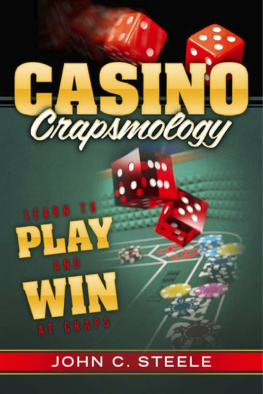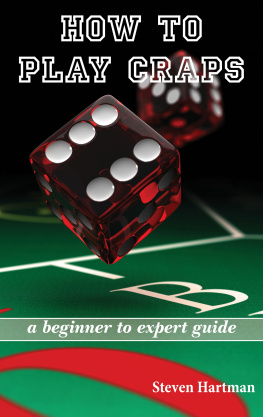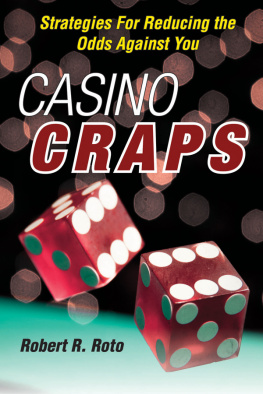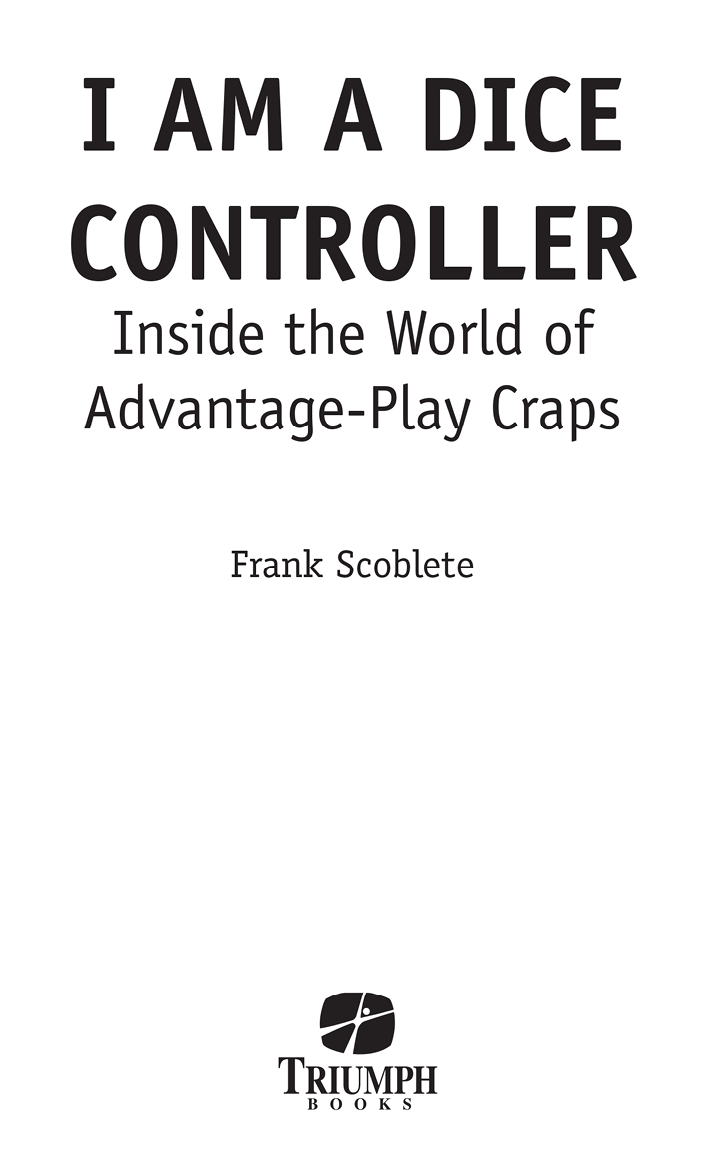
To the Captain and the Arm
Contents
Part I: The Captain
1. Dice Control: The New Frontier
I met my future wife, the Beautiful AP, when I was part owner of The Other Vic Theatre Company on Long Island in New York. Responding to an ad I had placed, AP applied for the job of stage manager. I have to be truthfulI loved her at first sight. She got the job.
She was a good stage manager and a good actress too. After she did several shows with us, she auditioned for the role of depressed chorus girl Fran Walker in the play The Only Game in Town by Frank D. Gilroy. I was the lead, Joe Grady, a degenerate craps player with a good heart. It was a powerful, funny, intense play about lives first lost and then found and the life-changing power of love. It also showed the degenerative power of a gambling addiction. I guess another title of the play could have been Losers in Love!
I faced a big problem, though. I had no idea what I was talking about when it came to casino gambling. Id have these really dramatic monologues about casino play, my good and bad streaks, and I wasnt sure what the words I uttered meant. The final monologue of the show, an uplifting David and Goliath story of one incredible night at the craps tables, had me emoting like crazy aboutwhat? I had no idea what the words meant.
This was in the mid-1980s. I had never been in a casino, nor had AP. We decided wed better take a trip to Atlantic City to learn what casino gambling and craps were all about.
We went to the Claridge because I had a personal interest in the historic hotel. In November 1946 I was conceived there. The Claridge was built in 1930 and became known as the Skyscraper by the Sea. The Claridge had an old-world charm. It also had the Captain and his high-rolling Crew.
Unquestionably the Captain had the most profound effect on my gambling life. Without his ideas and mentoring, I never would have become an advantage player or a successful writer of gambling articles and books.
We met the Captain at the Claridge. What the great Paul Keen was for me in blackjack (see my book I Am a Card Counter ), the Captain was even more for me in craps. He was the master, the conductor, the genius of the game, and I learned more from him about craps and casino gambling than I ever learned from any book.
It just so happened that during that period of time, the Captain and his Crew of 22 high rollers called the Claridge their home. So in a sense I was conceived in the Captains Atlantic City homethe very hotel that would launch my casino playing and writing career. My late father-in-law, Don Paone, would call that divine providence.
The Beautiful AP and I walked through the casino. I noted some interesting facts about blackjack, and then we headed over to the craps tables. I observed what was going on and was totally confused by the multitude of bets a craps player could make. Chips were flying all over the place.
Give me a yo!
Craps check!
How about snake eyes?
Hard 8, my man.
Any craps!
Big red!
Everything across.
The dealers were moving like lightningtaking chips and putting them on various numbers and symbols, paying off winners, taking from losers. It was mind-boggling, and then mind-numbing, and I wondered how people could play what appeared to be the most confusing game I had ever seen. Even the layout looked like some space aliens had designed it.
The Captain was about 65 years old then, and he could see that I was totally confused. He also heard me say to the Beautiful AP, Ill never learn this game. Its insane.
Yes, you will, he said. Most of the bets you are hearing players yelling, you can ignore. They are bad bets; I call them Crazy Crapper bets, and they should never be made. They sound good, but they stink. What you are hearing is a symphony in chaos.
That sold me: a symphony in chaos. The Captain could have been a writer if he so desired.
The way the Captain played the game was anything but chaotic. Eschewing all the bets he called Crazy Crapper Betssuch as the Horn, the Whirl, the craps numbers, the Hardways, the Field, and othersthe Captain instead focused on the Pass, Dont Pass, Come, and Dont Come.
It isnt enough just to bet these bets, you must have some rhythm with the dice, he said. Every bet has a casino edge on it, and to win you must overcome that edge. There is no other method to beat the casino at craps than good bets and rhythmic rolling.
The Captain firmly believed in this rhythmic rolling idea, the ability of some players to change the probabilities of the game based on the way they handled the dice. Today, we call such shooters dice controllers or dice influencers. He was convinced that if you made the right bets and threw the dice in a rhythmic way, the game could be beaten. In fact, he knew the game could be beaten because he had been doing just thatin a big wayfor more than a decade.
Dice control critics want to know why there arent dice controllers making millions playing the game. The critics present their arguments in a sarcastic way, not to win over those who are on the fence but merely to amuse those who already agree with them. The Captain made millions, as did Jimmy P. and several others that I know. The Captain was also a great teacher; he taught me everything I needed to know about advantage play.
Certainly, casinos try to protect themselves against dice manipulation by putting rubber pyramids against the back wall where the dice must hit. These pyramids supposedly randomize each and every throw. But for a good rhythmic roller, the pyramids just reduce the control; they do not fully randomize the results of most rolls.
The pyramids are a nuisance, nothing more, the Captain said. You can have some control even with them there. Your edge goes down when the dice hit them, but you can still have an edge. The casinos probably have no idea that their pyramids are not fully protecting them against rhythmic rollers.
The Captain also believed that many rhythmic rollers were not aware that they were changing the nature of the contest from one of randomness (which favored the casinos) to one of control (which favored the players). If you take a look at rhythmic rollers, there are certain things that they all show. They carefully set the dice the same way each time. They aim. They take care with the speed of the dice, with the slowest speed being the best. If you throw the dice in a slow way, when those dice hit the back wall they will not scoot all over the layout as a regular dice throwers will. They will tend to settle down in basically the same relationship with each other. It doesnt happen on every throwmany throws are randombut this happens with enough throws that some control is created. That control gives the player the edge if the player bets right.
Some rhythmic rollers in those days often said that they had great success at craps when they threw, never realizing that their luck was self-made because they were exerting some control over the outcome. In short, true skill could beat the game of craps. The Captain thought such rollers had helped him win since Atlantic Citys Resorts Casino first opened its doors in 1978.
From my more than a quarter century of personal experience at the craps tables, I can see that everything the Captain said about rhythmic rolling was correct. In those heady days of Atlantic Citys childhood, the Captain did the supposedly impossiblehe won a lot more than $1 million . Naturally those wins did not come in one night, one month, or even one year. Having an advantage at craps does not mean you will win every time you play. Much like in blackjack, the edge a player has is small but it is an edge, and the longer you play, the better chance you will be ahead.


